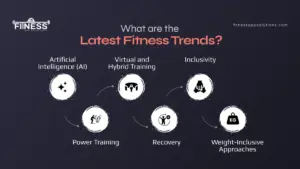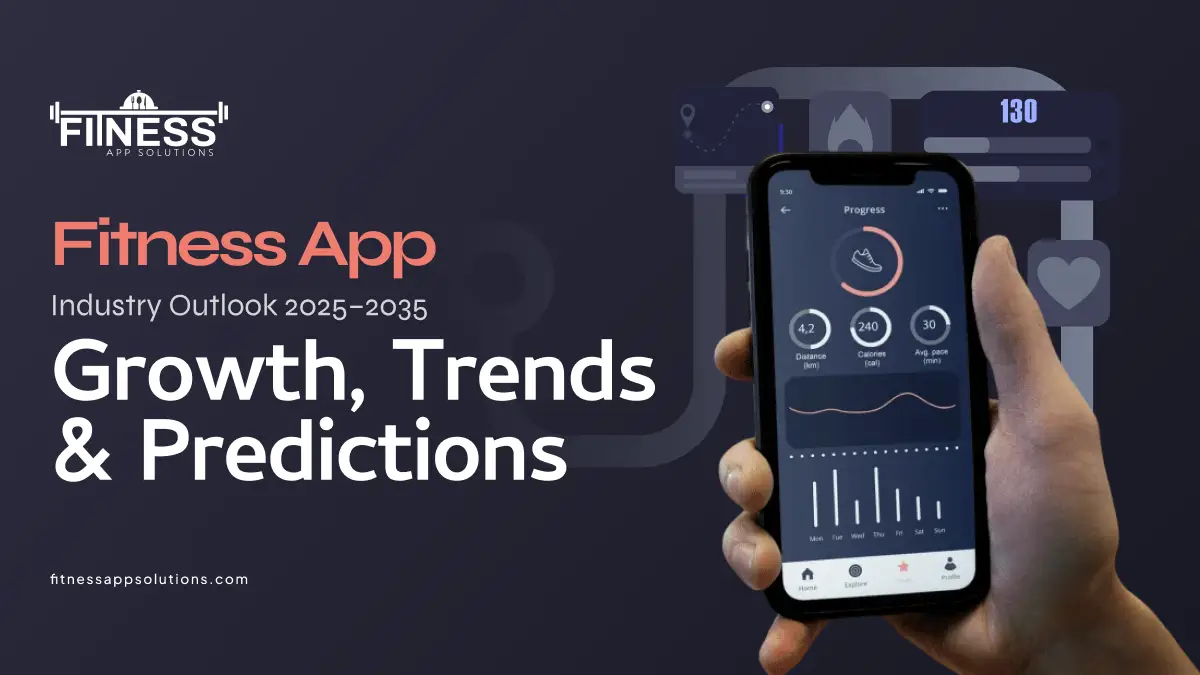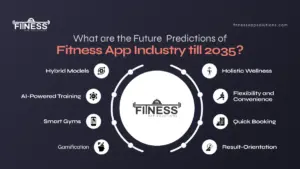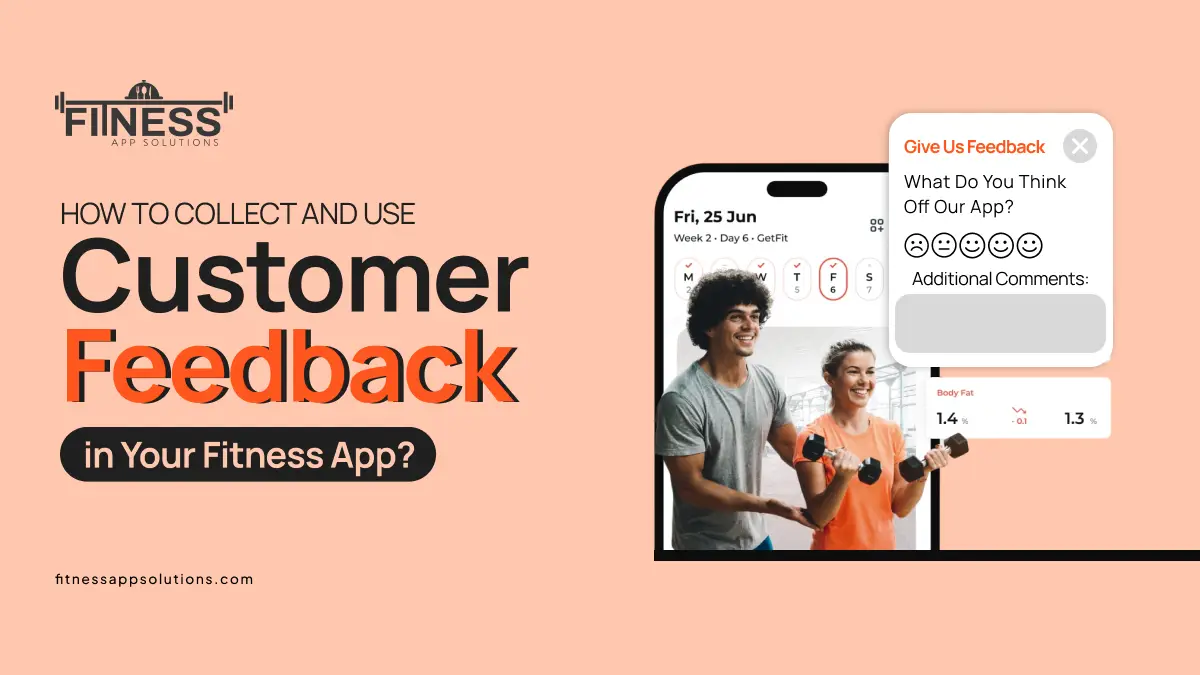The COVID-19 pandemic has played a vital role in shaping the fitness industry. During the pandemic, people preferred fitness apps to keep themselves healthy and fit. Industry leaders are leveraging various fitness trends and growth factors to stand out in the fitness app market competition.
The fitness app market is constantly buzzing with advanced trends. These rapidly growing trends empowers innovation and growth at its fullest.
By integrating the latest trends, fitness app development companies can project a higher sales rate and significantly enhance their revenue. Here in this guide, we will explore the latest fitness trends, growth projection of the fitness industry, along with its future predictions.
What are the Latest Fitness Trends?

Artificial Intelligence (AI)
AI is central to fitness in 2025, powering apps and wearables with real-time feedback and adaptive plans based on user data like metrics and goals. It scales trainer services and customizes experiences for better adherence. Professionals should blend AI with human motivation to maintain connections and stay competitive.
Wearable Technology Integration
Wearables like smartwatches provide real-time data on heart rate, sleep, and activity, becoming essential for trainers to offer precise guidance. They integrate with apps for ongoing monitoring and adjustments, enhancing client progress and safety in modern protocols.
Virtual and Hybrid Training
Virtual and hybrid models thrive for their convenience, with AR/VR creating immersive remote workouts. Post-pandemic demand remains high, allowing flexible access. Pros must master digital tools and adapt programs to expand reach and engagement.
Inclusivity
Inclusivity focuses on serving diverse groups like seniors, disabled individuals, and those with chronic conditions through barrier-free environments. It boosts retention and acquisition by tailoring approaches. Experts should adapt methods to promote equity and empowerment.
Power Training
Power training targets fast-twitch muscles for non-athletes, including adults and seniors, using quick, controlled movements with moderate resistance. It improves daily function, balance, and fall prevention. Implement progressively and individually for safe benefits.
Recovery
Recovery tools like foam rolling, massage guns, compression, cold therapy, saunas, shift to everyday use, reducing soreness, and aiding performance, plus mental health. Guide clients on options, stress rest, and avoid overtraining, as evidence evolves.
Weight-Inclusive Approaches
This trend promotes health at every size, emphasizing sustainable habits and body neutrality, overweight loss, and avoiding stigma. Align goals with values like strength building. Create positive spaces to enhance confidence and long-term engagement.
Food as Medicine
Nutrition prevents and treats chronic issues like diabetes via tailored meals and prescriptions for food-insecure groups. Covered by programs like Medicaid, it improves outcomes. Partner with healthcare to integrate balanced diets with fitness.
A More Holistic Approach
Holistic fitness combines exercise with mental health, stress management, sleep, and recovery as a lifestyle. Community via classes or apps builds accountability. Diversify into coaching and nutrition for better retention and revenue.
What are the Key Drivers of Fitness Trends?
COVID-19 Impact
Lockdowns accelerated digital fitness adoption, reducing reliance on traditional gyms and boosting virtual training.
Health Challenges
Increasing prevalence of chronic conditions like respiratory diseases (e.g., 251 million COPD cases globally in 2016 as per WHO), alongside aging populations and lifestyle diseases, drives demand for preventive tools.
Technological Integration
Apps connect with wearables for real-time tracking, supporting personalized routines and remote monitoring.
Demographic Shifts
Rapid urbanization, sedentary lifestyles, and a growing geriatric population emphasize accessible wellness solutions.
Social Media Influence
Platforms amplify fitness trends through influencers, building community and boosting user engagement.
Corporate Wellness Programs
Companies integrate apps into employee benefits to promote activity and cut healthcare costs, enhancing productivity.
Increased Accessibility and Affordability
Free, freemium, and low-cost models democratize fitness, attracting diverse demographics and projecting strong expansion.
What is the Growth Rate of Fitness Apps Industry?
Mental Health & Holistic Wellness: Meditation and stress tools broaden user appeal.Multiple lifestyle and tech trends converge to sustain strong growth across verticals.
| Category | Growth Metrics | Important Notes |
|---|---|---|
| Overall Market Expansion |
|
Strong medium-term growth, consistent base across economic uncertainties. |
| Historical Momentum |
|
Solid historical growth base driving future acceleration. |
| Year-Annual Growth Trajectory |
|
Growth steady rise in growth rate, momentum sustained via AI, personalization, and well-being tracking. |
| Key Growth Drivers | Health Awareness & Urban Lifestyles | Sedentary habits and wellness focus drive app adoption for fitness, diet, and well-being tracking. |
| Technological Advancements | Smartphone, AI integration, wearables, and real-time personalized plans enhance engagement and sustain 12.5% CAGR. | |
| Wearable Integration | Syncing of heart rate, sleep, calories, etc., drives activity tracking segment’s 14.9% CAGR. | |
| Mental Health & Holistic Wellness | Inclusion of meditation, stress, and sleep tools expands user base beyond physical fitness. | |
| Dominant Segments |
|
Majority remains in core activity-tracking; growing traction due to obesity concerns and wellness. |
| Platform Leadership | iOS: 58.3% market share (2023) | Preferred for security, Apple ecosystem, and premium user base. Focus on user experience. |
| Regional Growth Leaders | USA: 12.2% CAGR; 65.2% of North America market | High smartphone penetration and tech-savvy users. |
| India: 16.5% CAGR; 28.1% of South Asia & Pacific market | Urbanization, rising obesity, and busy lifestyles fuel demand. | |
| China: 15.4% CAGR; 52.2% of East Asia market | Fitness culture, supportive policies, and digital ecosystem growth. | |
| Regional Highlight | East Asia Overall: 19.3% CAGR (highest “hyperfast”) | Rapid adoption of technology and wellness culture driving expansion. |
(Source: Fitness Market Insights)
What are the Future Predictions of Fitness App Industry till 2035?
Hybrid Models
Hybrid models merge in-person sessions with virtual options, such as live-streamed classes, on-demand video libraries, and mobile apps, allowing members to access workouts anytime and anywhere. This approach increases convenience and broadens reach, especially for busy or remote clients, helping gyms maintain steady attendance.
AI-Powered Training
AI-powered training uses intelligent apps to analyse user data like fitness levels and goals, generating customized workout and nutrition plans with real-time adjustments. Emerging AI trainers act as virtual coaches, providing feedback during sessions, which makes professional guidance more accessible and scalable for gyms.
Smart Gyms
Smart gyms employ Internet of Things (IoT) technology in equipment to automatically track performance metrics, adjust resistance, and provide instant feedback. This creates a more efficient, data-driven environment that improves user experiences and retention by minimizing guesswork in training routines.
Gamification
Gamification introduces fun elements like challenges, rewards, leaderboards, badges, and progress milestones to workouts, turning routine exercises into interactive games. It boosts motivation and adherence, particularly for beginners, by fostering a sense of achievement and friendly competition within the community.
Holistic Wellness
Holistic wellness expands offerings to include mental health features like guided meditation, life coaching, balanced nutrition planning, and recovery methods such as cryotherapy or massage. This comprehensive approach addresses the whole person, appealing to clients seeking long-term well-being beyond just physical fitness.
Corporate Partnership
Corporate partnerships involve collaborating with businesses to deliver customized wellness programs, on-site sessions, or employee discounts for gym memberships. This opens new revenue streams and promotes workplace health, helping gyms tap into large, untapped corporate audiences.
Flexibility and Convenience
Flexibility and convenience features include mobile apps for instant booking, flexible membership tiers without rigid contracts, and self-service check-in kiosks. These tools save time for users and streamline operations for gyms, making fitness more approachable in fast-paced lifestyles.
Communication
Effective communication uses apps and digital platforms for seamless messaging, class announcements, and quick support responses, keeping members informed and connected. This builds trust and reduce frustration, ensuring clients feel supported throughout their fitness journey.
Quick Booking
Quick booking leverages user-friendly software to allow easy class reservations, cancelations, and real-time availability updates via mobile devices. This eliminates scheduling hassles, encouraging more frequent participation, and improving overall member satisfaction.
Result-Orientation
Result-Orientation employs dashboards, regular assessments, and progress reports to clearly demonstrate improvements in strength, endurance, or goals. This tangible feedback motivates clients and helps trainers refine programs for optimal outcomes.
Conclusion
The fitness app industry is poised for explosive growth through 2035, fuelled by a 12.5% CAGR and innovations like AI personalization, wearable integration, and holistic wellness. As trends such as inclusivity, hybrid training, and mental health features evolve, developers and businesses that prioritize user-centric, tech-driven solutions will dominate. By addressing urban lifestyles, health challenges, and corporate demands, the sector promises accessible, engaging fitness for all, transforming wellness into a seamless, sustainable lifestyle, and unlocking billions in revenue potential.
Frequently Asked Questions (FAQs)
What is the projected market size for fitness apps by 2035?
The market is expected to reach USD 22,276.6 million by 2035, up from USD 6,860.0 million in 2025.
Which fitness trend is driving the most growth?
AI-powered personalization and wearable integration lead, enabling real-time tracking and custom plans for better user adherence.
How has COVID-19 influenced the fitness app market?
It accelerated digital adoption, boosting virtual/hybrid models and home workouts, with lasting demand for remote fitness solutions.
What is the fastest-growing regional market?
East Asia, led by China at 15.4% CAGR and 52.2% share, driven by tech adoption and government wellness policies.
What future prediction stands out for 2035?
Hyper-personalized, gamified apps with VR/AR and holistic features will dominate, blending physical and mental wellness for lifelong engagement.




